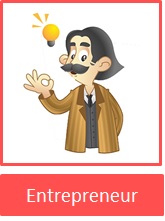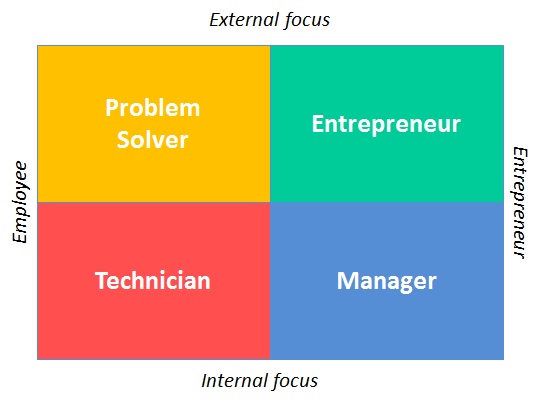Scene 2
Balancing Procurement Bench Strength:
The Future of Procurement: Shaping the Team
The Future of Procurement: Shaping the Team – In the previous post “Commanding the Stage” we discussed the players that are already shaping procurements future with whom the CPO must engage and command the stage.
Here we discuss the CPO’s talent pool and the players they can select to ensure they have the strongest bench.
In scene two, we introduce the critical actors available to the CPO when building their bench strength. Namely: Technicians, Managers Problem Solvers, and Entrepreneurs.
For this discussion, entrepreneurs are not someone who has started a company; rather the attitude they have about their role in the organization. Do they see themselves as having ownership for company success or are they an employee filling a position in the organizational chart? Whatever the role, each player on the bench must operate to variable degrees in four dimensions (Fig 1) depending upon the role and the organizational context:
- Entrepreneur
- Technician
- External Focus
- Internal Focus
Each team members mindset is critical.
1. An Employee or Entrepreneur?
An employee regards their role as a position on an organizational chart. They have a prescribed area of responsibility and have specific tasks for which they are responsible. Their mindset is to do their job and do it well. They are willing to act within their area of responsibility – even improvise a bit, but tend not to move outside their area of responsibility without specific direction.
In contrast, the entrepreneur mindset, is not focused on just their position on the organizational chart. They maintain awareness of what is going on across the whole company and strive to improve the organization’s ability to reach its goals, feeling personal ownership for organizational success. Wherever they see opportunities, they either act to take advantage or influence others to act.
Every CPO needs both kinds of thinking to be present to expand procurements influence in the business successfully. Employees protect everything that has made the business great while entrepreneur’s question everything past and present to make sure of its continued relevance and that it still works.
Too much entrepreneurial thinking, however, might just land you with a mountain of ideas and initiatives that go nowhere and eat value while too much employee thinking might keep your business sound but too risk averse. The CPO must find the right balance.
1.1 Internal or External Focus
When reviewing the entrepreneur – technician make-up of your team there are two further choices for skill-based attention: internal focus and external focus dimensions:
- Someone with an internal focus is likely to focus on variables such as management structures, workforce development, tasks and the layout of operational processes.
- Someone with an external focus is likely to focus on variables originating outside of a company, such as suppliers, technological innovation, consumer preferences and competitors’ actions.
CPO’s must also understand the risk appetite of each member of their team to determine best if they have the type of personality that is conducive to success in their role withing the organizational context?
2. Risk Tolerance
Taking a deep look at the risk appetite of your team will help to understand their overall mindset and attitude and allow you to understand best if they will support or hinder your goals.
People who have a low risks appetite are unlikely to make good entrepreneurs while those people who are willing to take risks are unlikely to be satisfied doing a technician type role.
People’s risk appetite needs alignment to organization’s risk tolerance. CPO’s, therefore, require a balance of someone willing to take risks, while mindful of the organization’s risks tolerance and can make the right calculations so as to not put the business in jeopardy.
CPO’s and managers must, therefore, define the rules for delegating risk taking and the processes for escalating risk when it arises in line with the organization’s risk tolerance.
3. The players
Bench strength is critical to any performance oriented team. CPO’s can maximize the strength of their procurement team by ensuring the optimum mix of knowledge, skills and experience required to succeed in their organizational context. Besides the usual technical skill’s CPO’s should balance the mix of players operating along the entrepreneur – technician continuum (Fig 2). When all these traits are in balance, the CPO has the recipe for a high-performance team.
3.1 Technician
The technician is the employee with an internal focus, and they regard their work as the business. They are hands on specialist who follow the guiding structure of the company’s systems to get the work done in the present. The organization chart defines how things work and who does what.
 Value Creation
Value Creation
Customer Centricity
Mindset:
Risk tolerance
Most technicians seek job security over the longer term. Consequently, they are likely to be concerned about new challenges or doing something risky in case they fail.
3.2 Problem Solver
The problem solver is the employee with an external focus. They are recognized experts having already mastered the technical skills that exemplify their expertise, knowledge, and ability to create value for stakeholders.
 Value Creation
Value Creation
The ability to analyze issues objectively means they focus on the facts and are determined to overcome ambiguity, to collect information and seek out details. They have to dig to discover the answers to who, what, why, when, how and where to then test options by engaging stakeholders to agree the solution.
Customer Centric
Mindset
Risk tolerance
The ability to tolerate ambiguity is all about risk taking. Problem solvers are required to make decisions even though the information is incomplete or conflicting in nature. They must, therefore, have the courage to make a decision to avoid analysis paralysis, procrastination or postponement caused by the fear of failure or success. They must then possess the courage to act on their decision.
3.3 Managers
The manager operates in a complex world, highlighted in a great HBR article. They are the forward thinking employee with an internal focus, they have mastered the technical and stakeholder skills and know how to get work done within the boundaries of their job role. They understand these boundaries but are also able to step up and challenge them where appropriate.
 Value Creation
Value Creation
Managers need to seek actively to expand procurements scope and influence using the structures of the organization. Requiring them to prioritize opportunities and to take on additional responsibilities, where procurement can add value to work being done by other functions.
Customer Centric
Mindset
They have an internal focus with growth mindsets. The HBR article describes five manager mindsets highlighting that “everything an effective manager does is sandwiched between action on the ground and reflection in the abstract”. The mindsets detailed are:
1. Reflective
2. Analytic
3. Worldly
4. Collaborative
5. Action
The article points out that we will all have a natural learning to some more than others. The key being for the manager to effectively weave the mindsets together.
Risk tolerance
3.4 Entrepreneur
The entrepreneur is focused on the future constantly searching for new ideas and opportunities previously unavailable to the organization. They seek to blur the boundaries of their role to work more closely with others who impact their work. Their external focus seeks to bring the outside market inside to create value.
 Value Creation
Value Creation
They have strong self-belief and are more in control than controlled. They exemplify and elevate awareness and acceptance of the purpose and mission of the organization.
Entrepreneurs have a skill for finding value where others don’t even think to look, evaluating value propositions quickly to determine which options to pursue and which to reject.
Opportunity capture prioritizes contribution to key metrics and value-added activities, so they have a clear vision of how they can influence the business and organize to prioritize strategic work.
Customer Centric
Mindset
As drivers of change, they can be perceived in the organization as disruptive. Some may see them as a threat to the status quo and undisciplined.
Risk tolerance
The entrepreneur has a tolerance for ambiguity and tolerance for risk and is comfortable managing it. They know that failing to attempt something is a greater failure than trying and not succeeding. What others may judge as a ‘risky situation’, entrepreneurs see as an opportunity for a higher reward.
4. Conclusion
The shaping of procurements future not only needs a strategy for the end game we discussed in scene one. It needs the right team to execute the strategy. Without one or the other the CPO is left drifting, reacting to events around them. I have put forward a proposition as to the make-up of the CPO’s bench comprising the skills and mindsets necessary to continue procurements drive towards greater value.
The Entrepreneur is arguably the most important member, and the one that can bring the most value to your business. The roles that the Technician, Problem Solver and Manager perform are functions of the vision, strategy and plans the Entrepreneur forges. If the Entrepreneurs vision has a fixed focus on sourcing and cost savings, then the others will only aspire to match that scope and vision.
The Entrepreneur is, therefore, the leader; the Technician, Problem Solver, and Manager are the led. The Technician, Problem Solver, and Manager should have the potential to rise to the level of the Entrepreneur. The Entrepreneur will never aspire to be either of the other roles. Consequently, procurement professionals, must aspire to gain quickly the technical knowledge of the Technician, stakeholder skills of the Problem Solver and systems and political skills of the Manager to begin the process of developing the Entrepreneur.
Nuff said…



